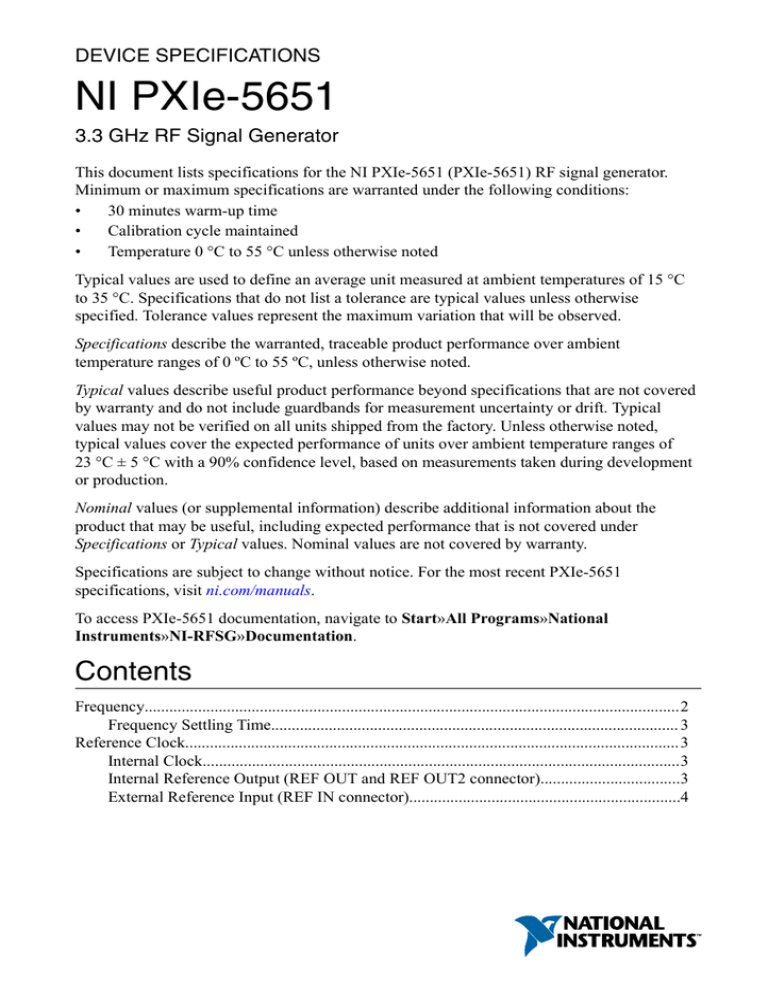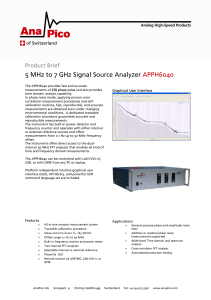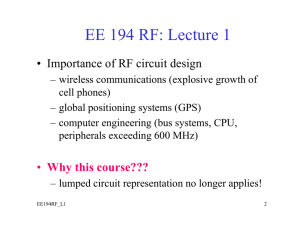
DEVICE SPECIFICATIONS
NI PXIe-5651
3.3 GHz RF Signal Generator
This document lists specifications for the NI PXIe-5651 (PXIe-5651) RF signal generator.
Minimum or maximum specifications are warranted under the following conditions:
•
30 minutes warm-up time
•
Calibration cycle maintained
•
Temperature 0 °C to 55 °C unless otherwise noted
Typical values are used to define an average unit measured at ambient temperatures of 15 °C
to 35 °C. Specifications that do not list a tolerance are typical values unless otherwise
specified. Tolerance values represent the maximum variation that will be observed.
Specifications describe the warranted, traceable product performance over ambient
temperature ranges of 0 ºC to 55 ºC, unless otherwise noted.
Typical values describe useful product performance beyond specifications that are not covered
by warranty and do not include guardbands for measurement uncertainty or drift. Typical
values may not be verified on all units shipped from the factory. Unless otherwise noted,
typical values cover the expected performance of units over ambient temperature ranges of
23 °C ± 5 °C with a 90% confidence level, based on measurements taken during development
or production.
Nominal values (or supplemental information) describe additional information about the
product that may be useful, including expected performance that is not covered under
Specifications or Typical values. Nominal values are not covered by warranty.
Specifications are subject to change without notice. For the most recent PXIe-5651
specifications, visit ni.com/manuals.
To access PXIe-5651 documentation, navigate to Start»All Programs»National
Instruments»NI-RFSG»Documentation.
Contents
Frequency..................................................................................................................................2
Frequency Settling Time................................................................................................... 3
Reference Clock........................................................................................................................ 3
Internal Clock....................................................................................................................3
Internal Reference Output (REF OUT and REF OUT2 connector)..................................3
External Reference Input (REF IN connector)..................................................................4
Spectral Purity...........................................................................................................................4
Harmonics......................................................................................................................... 7
Nonharmonics................................................................................................................... 8
Amplitude..................................................................................................................................9
Power Level Accuracy.................................................................................................... 10
Amplitude Settling Time................................................................................................. 11
Signal-to-Noise Ratio......................................................................................................12
Voltage Standing Wave Ratio (VSWR).......................................................................... 12
Reverse Power Handling.................................................................................................12
Modulation.............................................................................................................................. 12
Frequency Modulation (FM)...........................................................................................12
Frequency Shift Keying (FSK)....................................................................................... 13
On-Off Keying (OOK)....................................................................................................15
DC Power Requirements.........................................................................................................16
Calibration...............................................................................................................................17
Physical Dimensions............................................................................................................... 17
Environment............................................................................................................................17
Operating Environment...................................................................................................17
Storage Environment.......................................................................................................17
Shock and Vibration................................................................................................................18
Compliance and Certifications................................................................................................18
Safety.............................................................................................................................. 18
Electromagnetic Compatibility....................................................................................... 18
CE Compliance .............................................................................................................. 19
Online Product Certification........................................................................................... 19
Environmental Management........................................................................................... 19
Frequency
Range1
500 kHz to 3.3 GHz
Resolution
500 kHz to <1.3 GHz
<3 Hz
1.3 GHz to <3.3 GHz
<6 Hz
Accuracy
1
2
|
Refer to the Reference Clock section.
Tunable down to 100 kHz with amplitude uncalibrated.
ni.com |
NI PXIe-5651 Specifications
Frequency Settling Time2
Table 1. Narrow Loop Bandwidth
Settling Time (ppm)
Median (ms)
Maximum (ms)
≤0.01
6.5
13
≤0.1
1.5
6.53
Table 2. Wide Loop Bandwidth
Settling Time (ppm)
Median (ms)
Maximum (ms)
0.01
1.0
5.0
0.1
0.3
1.0
1.0
0.2
0.7
Reference Clock
Internal Clock
Initial accuracy
±3 ppm, maximum
Temperature (15 ºC to 35 ºC)
±1 ppm, maximum
Aging
±5 ppm per year, maximum
Internal Reference Output
(REF OUT and REF OUT2 connector)
Frequency
10 MHz
Amplitude
1 Vpk-pk into 50 Ω
Coupling
AC
Output impedance
50 Ω
2
3
The frequency settling time specification includes only frequency settling and excludes any
residual amplitude settling that may occur as the result of a large frequency change.
Frequency steps that span the full range of a voltage-controlled oscillator (VCO) require more
settling time than steps that remain close together within one VCO or steps that switch between
VCOs. The maximum specification covers this worst-case frequency settling time.
NI PXIe-5651 Specifications
|
© National Instruments
|
3
External Reference Input (REF IN connector)
Frequency
10 MHz ±10 ppm
Amplitude
0.2 Vpk-pk to 1.5 Vpk-pk into 50 Ω
Input impedance
50 Ω
Lock time to external reference
<1 s
Spectral Purity
Table 3. Single Sideband (SSB) Phase Noise at 10 kHz Offset4
Frequency
Phase Noise (dBc/Hz)
100 MHz
<-125, typical
500 MHz
<-111
1 GHz
<-105
2 GHz
<-98
3 GHz
<-95
Residual FM (300 Hz to 3 kHz, RMS)
1 GHz
<0.8 Hz RMS, typical
2.4 GHz
<1.5 Hz RMS, typical
Jitter5
4
5
4
|
(seconds, RMS)
622 MHz with 1 kHz to 5 MHz jitter
bandwidth
<200 fs, typical
2.488 GHz with 5 kHz to 15 MHz
jitter bandwidth
<50 fs, typical
Wide loop bandwidth has very similar phase noise performance at 10 kHz offset, but this noise
level extends to approximately 300 kHz offset before it starts rolling down at approximately 20 dB
per decade until it reaches the far out noise density.
Measured at 0 dBm output power.
ni.com |
NI PXIe-5651 Specifications
Figure 1. Measured Phase Noise at 500 MHz and 1 GHz (0 dBm Output Power)
–70
500 MHz
1.0 GHz
–80
–90
dBc/Hz
–100
–110
–120
–130
–140
–150
100
1k
10 k
100 k
1M
10 M
Frequency Offset (Hz)
Figure 2. Measured Phase Noise at 1.8 GHz and 2.4 GHz (0 dBm Output Power)
–70
1.8 GHz
2.4 GHz
–80
–90
dBc/Hz
–100
–110
–120
–130
–140
–150
100
1k
10 k
100 k
1M
10 M
Frequency Offset (Hz)
NI PXIe-5651 Specifications
|
© National Instruments
|
5
Figure 3. Measured Phase Noise at 3.0 GHz (0 dBm Output Power)
–70
–80
–90
dBc/Hz
–100
–110
–120
–130
–140
–150
100
1k
10 k
100 k
1M
10 M
Frequency Offset (Hz)
Figure 4. Measured Phase Noise at 3.0 GHz in Narrow and Wide Loop Bandwidth
(0 dBm Output Power)
–70
Narrow Loop Bandwidth
Wide Loop Bandwidth
–80
–90
dBc/Hz
–100
–110
–120
–130
–140
–150
100
1k
10 k
100 k
Frequency Offset (Hz)
6
|
ni.com
|
NI PXIe-5651 Specifications
1M
10 M
Harmonics
500 kHz to 3.3 GHz (0 dBm to -50 dBm
output power)
-24 dBc
Figure 5. Typical Spectrum at 2.45 GHz
0
–10
–20
Power (dBm)
–30
–40
–50
–60
–70
–80
–90
10 M
1.0 G
2.0 G
3.0 G
4.0 G
6.0 G 6.6 G
5.0 G
Frequency (Hz)
NI PXIe-5651 Specifications
|
© National Instruments
|
7
Figure 6. Typical Second Harmonic (HD 2) and Third Harmonic (HD 3) Levels (0 dBm
Output Power)
–20
HD 2
HD 3
Harmonic Level (dBC)
–30
–40
–50
–60
–70
–80
–90
500 k
500 M
1G
1.5 G
2G
2.5 G
3G
3.3 G
Frequency (Hz)
Nonharmonics
Narrow Loop Bandwidth
Table 4. Nonharmonic Products at 0 dBm to -20 dBm Output Power
Frequency
<3 kHz Offset (dBc),
Typical
>3 kHz Offset (dBc) >100 kHz Offset (dBc)
500 kHz to <50 MHz <-57
<-57
<-57
50 MHz to <3.3 GHz <-65
<-65
<-70
8
|
ni.com |
NI PXIe-5651 Specifications
Wide Loop Bandwidth
Table 5. Nonharmonic Products at 0 dBm to -20 dBm Output Power
Frequency
<3 MHz Offset (dBc), Typical
>3 MHz Offset (dBc), Typical
500 kHz to <50 MHz
<-57
<-57
50 MHz to <3.3 GHz
<-44
<-70
Subharmonic products 500 kHz to
3.3 GHz
Not applicable6
Amplitude
Resolution
<0.1 dB
Table 6. Amplitude Range
Frequency
Amplitude (dBm)
500 kHz to <10 MHz
-90 to 5
10 MHz to <50 MHz
-90 to 8
50 MHz to <500 MHz
-90 to 10
500 MHz to <1.3 GHz
-90 to 10
1.3 GHz to <1.6 GHz
-90 to 10
1.6 GHz to <2.9 GHz
-80 to 8
2.9 GHz to <3.3 GHz
-70 to 8
Maximum available power
2 dB above maximum specified amplitude,
typical
Minimum available power
10 dB below minimum specified amplitude,
typical
6
No harmonic multiplication in this band.
NI PXIe-5651 Specifications
|
© National Instruments
|
9
Figure 7. Measured Maximum Available Power
20
18
16
Power (dBm)
14
12
10
8
6
4
2
0
500 k
500 M
1G
1.5 G
2G
2.5 G
3 G 3.3 G
Frequency (Hz)
Power Level Accuracy
Table 7. Power Level Accuracy (15 °C to 35 °C)
Frequency
>-40 dBm Output Power (dB)
≤-40 dBm Output Power (dB)
500 kHz to <10 MHz
±1.6
±2.2
10 MHz to <3.3 GHz
±0.75
±1.8
10
|
ni.com
|
NI PXIe-5651 Specifications
Figure 8. Typical Power Accuracy, -40 dBm to 0 dBm, 5 dB Steps
1.0
Error (dB)
0.5
0.0
–0.5
–1.0
0
1G
2G
3G
3.3 G
Frequency (Hz)
Figure 9. Typical Power (0 dBm) at 2.4 GHz Over Time7
0.00
Power (dBm)
–0.01
–0.02
–0.03
–0.04
0
60
180
120
240
300
Minutes
Amplitude Settling Time
0.05 dB of final value
<500 ms, typical
0.25 dB of final value
<10 ms, typical
7
Calling the niRFSG Perform Thermal Correction VI or
niRFSG_PerformThermalCorrection function once per minute.
NI PXIe-5651 Specifications
|
© National Instruments
|
11
Signal-to-Noise Ratio
≥0 dBm output power
<-140 dBc/Hz, typical
Voltage Standing Wave Ratio (VSWR)
500 kHz to 3.3 GHz
<1.8:1, typical
Output impedance
50 Ω
Figure 10. Measured VSWR
2.0
1.8
1.6
VSWR
1.4
1.2
1.0
0.8
0.6
0.4
0 dBm
0 dBm
0.2
0
0
1G
2G
3G
3.3 G
Frequency (Hz)
Reverse Power Handling
RF
0.5 watts, +27 dBm8
DC
25 volts
Modulation
Frequency Modulation (FM)
Modulation waveform types
Sine, triangle, square
External modulation source
Not supported
8
12
|
If the requested output power is less than -3 dBm, the RF reverse power handling is +15 dBm for
signals ≤10 MHz.
ni.com |
NI PXIe-5651 Specifications
Table 8. FM Typical Maximum Deviation
Frequency Range
Typical Maximum Deviation (Sine Wave)
500 kHz to <50 MHz
500 kHz
50 MHz to <100 MHz
125 kHz
100 MHz to <200 MHz
250 kHz
200 MHz to <400 MHz
500 kHz
400 MHz to <800 MHz
1 MHz
800 MHz to <1.6 GHz
2 MHz
1.6 GHz to <3.3 GHz
4 MHz
Modulation waveform frequency
Characteristic deviation
accuracy9
1 Hz to 100 kHz
<±3.5%
Typical distortion9
<0.1%
SINAD9
>65 dB
Frequency Shift Keying (FSK)
Modulation waveform types
PRBS
5-order to 31-order
User-defined
Up to 1,022 bit
Modulation format
2-FSK
Table 9. FSK Typical Maximum Deviation
Frequency Range
Typical Maximum Deviation
500 kHz to <50 MHz
250 kHz
50 MHz to <100 MHz
31.25 kHz
100 MHz to <200 MHz
62.5 kHz
200 MHz to <400 MHz
125 kHz
400 MHz to <800 MHz
250 kHz
9
1 kHz sine wave, 10% of maximum deviation; noise bandwidth of 10 kHz.
NI PXIe-5651 Specifications
|
© National Instruments
|
13
Table 9. FSK Typical Maximum Deviation (Continued)
Frequency Range
Typical Maximum Deviation
800 MHz to <1.6 GHz
500 kHz
1.6 GHz to <3.3 GHz
1 MHz
FSK characteristic deviation accuracy
(100 kHz rate, 10% of maximum
deviation)
<±10%
Symbol rate
PRBS
763 Hz to 100 kHz
User-defined
763 Hz to 100 kHz
Pulse shaping
Not supported
Figure 11. FSK Modulation Eye Diagram, 1.0 GHz Carrier, 100 kHz Symbol Rate,
500 kHz Deviation, Ninth-Order PRBS
750 k
Frequency (Hz)
500 k
250 k
0
–250 k
–500 k
–750 k
0
10 µ
20 µ
30 µ
Time (sec)
14
|
ni.com |
NI PXIe-5651 Specifications
40 µ
50 µ
Figure 12. FSK Modulation Eye Diagram, 2.4 GHz Carrier, 100 kHz Symbol Rate,
1.0 MHz Deviation, Ninth-Order PRBS
1.5 M
Frequency (Hz)
1.0 M
500 k
0
–500 k
–1.0 M
–1.5 M
0
10 µ
20 µ
30 µ
40 µ
50 µ
Time (sec)
On-Off Keying (OOK)
Modulation waveform types
PRBS
5-order to 31-order
User-defined
Up to 1,024 bit
Table 10. OOK Typical Amplitude
Frequency Range
Typical Amplitude (dBm)
500 kHz to <10 MHz
-3 to 5
10 MHz to <50 MHz
-3 to 8
50 MHz to <1.6 GHz
-3.5 to 10
1.6 GHz to <3.3 GHz
-2.5 to 8
Symbol rate
PRBS
153 Hz to 100 kHz
User-defined
153 Hz to 100 kHz
Pulse shaping
Not supported
NI PXIe-5651 Specifications
|
© National Instruments
|
15
Figure 13. OOK Diagram, 1.0 GHz Carrier, 100 kHz Symbol Rate, Ninth-Order PRBS
10
Power Level (dBm)
0
–20
–40
–60
50 µ
0
100 µ
150 µ
200 µ
Time (sec)
Figure 14. OOK Diagram, 1.0 GHz Carrier, 200 kHz Symbol Rate, Ninth-Order PRBS
10
Power Level (dBm)
0
–10
–20
–30
–40
–50
–60
50 µ
0
100 µ
150 µ
200 µ
Time (sec)
DC Power Requirements
Table 11. DC Power Requirements
Voltage (VDC)
Maximum Current (A)
Typical Current (A)
+3.3
1.00
0.90
+12
1.00
0.80
16
|
ni.com
|
NI PXIe-5651 Specifications
Calibration
Interval
1 year
Physical Dimensions
PXIe-5651 module
3U, one slot, PXI Express module
2.0 cm × 13.0 cm × 21.6 cm
(0.8 in. × 5.1 in. × 8.5 in.)
Weight
415 g (14.6 oz)
Environment
Maximum altitude
2,000 m (800 mbar) (at 25 °C ambient
temperature)
Pollution Degree
2
Indoor use only.
Operating Environment
Ambient temperature range
0 °C to 55 °C (Tested in accordance with
IEC 60068-2-1 and IEC 60068-2-2. Meets
MIL-PRF-28800F Class 3 low temperature
limit and MIL-PRF-28800F Class 2 high
temperature limit.)
Relative humidity range
10% to 90%, noncondensing (Tested in
accordance with IEC 60068-2-56.)
Storage Environment
Ambient temperature range
-40 °C to 70 °C (Tested in accordance with
IEC 60062-2-1 and IEC 60068-2-2.)
Relative humidity range
5% to 95%, noncondensing (Tested in
accordance with IEC 60068-2-56.)
NI PXIe-5651 Specifications
|
© National Instruments
|
17
Shock and Vibration
Nonoperational shock
30 g peak, half-sine, 11 ms pulse (Tested in
accordance with IEC 60068-2-27. Test profile
developed in accordance with
MIL-PRF-28800F.)
Random vibration nonoperating
5 Hz to 500 Hz, 2.4 grms (Tested in accordance
with IEC 60068-2-64. Nonoperating test
profile exceeds the requirements of
MIL-PRF-28800F, Class 3.)
Compliance and Certifications
Safety
This product is designed to meet the requirements of the following electrical equipment safety
standards for measurement, control, and laboratory use:
•
IEC 61010-1, EN 61010-1
•
UL 61010-1, CSA 61010-1
Note For UL and other safety certifications, refer to the product label or the Online
Product Certification section.
Electromagnetic Compatibility
This product meets the requirements of the following EMC standards for electrical equipment
for measurement, control, and laboratory use:
•
EN 61326-1 (IEC 61326-1): Class A emissions; Basic immunity
•
EN 55011 (CISPR 11): Group 1, Class A emissions
•
AS/NZS CISPR 11: Group 1, Class A emissions
•
FCC 47 CFR Part 15B: Class A emissions
•
ICES-001: Class A emissions
Note In the United States (per FCC 47 CFR), Class A equipment is intended for
use in commercial, light-industrial, and heavy-industrial locations. In Europe,
Canada, Australia, and New Zealand (per CISPR 11), Class A equipment is intended
for use only in heavy-industrial locations.
Note Group 1 equipment (per CISPR 11) is any industrial, scientific, or medical
equipment that does not intentionally generate radio frequency energy for the
treatment of material or inspection/analysis purposes.
18
|
ni.com |
NI PXIe-5651 Specifications
Note For EMC declarations, certifications, and additional information, refer to the
Online Product Certification section.
CE Compliance
This product meets the essential requirements of applicable European Directives, as follows:
•
2006/95/EC; Low-Voltage Directive (safety)
•
2004/108/EC; Electromagnetic Compatibility Directive (EMC)
Online Product Certification
Refer to the product Declaration of Conformity (DoC) for additional regulatory compliance
information. To obtain product certifications and the DoC for this product, visit ni.com/
certification, search by model number or product line, and click the appropriate link in the
Certification column.
Environmental Management
NI is committed to designing and manufacturing products in an environmentally responsible
manner. NI recognizes that eliminating certain hazardous substances from our products is
beneficial to the environment and to NI customers.
For additional environmental information, refer to the Minimize Our Environmental Impact
web page at ni.com/environment. This page contains the environmental regulations and
directives with which NI complies, as well as other environmental information not included in
this document.
Waste Electrical and Electronic Equipment (WEEE)
EU Customers At the end of the product life cycle, all NI products must be
disposed of according to local laws and regulations. For more information about
how to recycle NI products in your region, visit ni.com/environment/weee.
电子信息产品污染控制管理办法(中国 RoHS)
中国客户 National Instruments 符合中国电子信息产品中限制使用某些有害物
质指令(RoHS)。关于 National Instruments 中国 RoHS 合规性信息,请登录
ni.com/environment/rohs_china。(For information about China RoHS
compliance, go to ni.com/environment/rohs_china.)
NI PXIe-5651 Specifications |
© National Instruments
|
19
Refer to the NI Trademarks and Logo Guidelines at ni.com/trademarks for information on NI trademarks. Other product and
company names mentioned herein are trademarks or trade names of their respective companies. For patents covering NI
products/technology, refer to the appropriate location: Help»Patents in your software, the patents.txt file on your media, or the
National Instruments Patent Notice at ni.com/patents. You can find information about end-user license agreements (EULAs)
and third-party legal notices in the readme file for your NI product. Refer to the Export Compliance Information at ni.com/
legal/export-compliance for the NI global trade compliance policy and how to obtain relevant HTS codes, ECCNs, and other
import/export data. NI MAKES NO EXPRESS OR IMPLIED WARRANTIES AS TO THE ACCURACY OF THE INFORMATION
CONTAINED HEREIN AND SHALL NOT BE LIABLE FOR ANY ERRORS. U.S. Government Customers: The data contained in
this manual was developed at private expense and is subject to the applicable limited rights and restricted data rights as set forth
in FAR 52.227-14, DFAR 252.227-7014, and DFAR 252.227-7015.
© 2009—2016 National Instruments. All rights reserved.
375086A-01
Jun16



